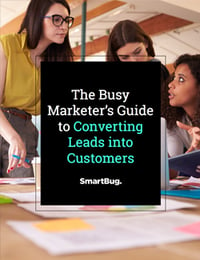
Conversion Rate Optimization: 10 Fast Tips for Busy Marketers
May 30, 2023
By Amanda Hurd
Conversion rate optimization (CRO) can be one of the biggest challenges marketers face; after all, high volumes of traffic don’t pay the bills. And although it’s great to rank No. 1 on Google, if visitors to your website aren’t converting down the sales funnel into customers, there is a problem that needs solving.
Many marketers truly believe they’re doing everything right when it comes to providing an optimal conversion journey for their visitors. But the numbers don’t lie, and if you don’t have conversions, it’s time to stop repeating the mantra, “It’s not me, it’s them.” Instead, formulate an action plan to address the problem of why visitors aren’t turning into customers with these fast tips for busy marketers.
What Is Conversion Rate Optimization?
This is where we hit you with the textbook definition of CRO:
“Conversion rate optimization, or CRO, is the process of increasing the percentage of users or website visitors who complete a specific action to increase the number of leads you generate.”
.gif?width=480&height=480&name=giphy%20(18).gif)
Let’s be honest—does any marketer really know what that means? Sure, we know how to figure it out:
Conversion rate = The number of conversions/the number of total visitors x 100
But what does CRO mean when we close the textbook and take a look at user behavior?
A few short decades ago, when consumers needed shoes, they went to a shoe store. When they needed to find someone to fix a leaky faucet, they cracked open the Yellow Pages to “plumbers” and made a phone call. It was a safe bet that if a person was in a shoe store or calling a plumber, they intended to explore a purchase.
Consumers haven’t changed, but how they find products and services has, and those marketers who can prime their digital “shop” toward the buyer will win more business over the competition.
Why Conversion Rate Optimization Is Important
Think of CRO in the digital world like sales floor associates in the brick-and-mortar world. When a consumer enters a physical store, they expect a certain experience. Conversion rate optimization is bringing that experience to your digital storefront—your website— whether you are selling products or services.
Some marketers may opt to try and increase traffic to their website, following the mindset that an increase in traffic will have a subsequent increase in conversions. You wouldn’t be wrong, and you’d be in great company—Neil Patel makes a great case for this.
But to increase traffic enough that it leads to an increase in conversions takes time and resources. For busy marketers, it can be a herculean task, especially when some quick wins such as CRO could mean a faster increase in how many new contacts find their way to the sales team’s inbox.
For example, let’s say your sales team has a close rate of 30 percent. You are currently converting 3 percent of the traffic that comes to your homepage. Your traffic is about 3,000 visitors per month.
At the 3 percent conversion rate, you are driving 90 new leads to sales. Sales closed 27 of those 90 leads.
Now let’s say sales wanted to close 30 leads per month instead of 27. To meet this goal for customers, you could:
.gif?width=480&height=480&name=giphy%20(19).gif)
Focusing on traffic alone leaves money on the table. By increasing your conversion rate a few tenths of a point, busy marketers can gain quick wins that help build the bottom line.
Conversion Rate Optimization Tips to Win the Game
Savvy marketers need a plan of action to achieve goals. To build your conversion optimization plan, follow these tips:
1. Define your conversion goals.
CRO starts with identifying what action users should take on your website to convert. These actions could include adding products to an e-commerce cart or filling out a form to download a case study or e-book. Conversions could also be demo or contact requests. Defining your goals is the first step to identifying if there are enough conversion opportunities available to users to meet them.
2. Record historical results.
Marketers often ask the question, “What is a good conversion rate?” You're likely to get a wide variety of conversion rate optimization statistics depending on your industry, traffic source, and a dozen other factors. The truest answer to this question is, “It depends on your data.” If a “good” rate is 10 percent, and historically your best-converting page is below 1 percent, it is going to feel overwhelming to even try to achieve what others tout as the “best practice.”
A better way to define a “good” conversion rate for your company is to find your highest-converting page and look at the average over six months to a year. Set that number as your benchmark. Then develop a plan to increase that rate by 0.25-0.5 percent over a dedicated period.
3. Identify your money page.
Armed with what actions qualify for a conversion and your historical rate to increase, our third conversion rate optimization tip for building a winning game plan is to identify the page (or pages) where you have the most opportunity. Here’s how to find those pages:
- Filter your pages by the most unique users over time (six months to a year is a good range).
- Then filter your pages by the highest conversion rate.
- Your “money page” is where these two data points intersect (i.e., the page with the most traffic also has the highest conversions).
Often, the homepage or pricing page of a website will have the most conversion opportunity.
If your data is inconclusive, use your best judgment to choose the page with the most traffic that also has a conversion rate above your overall annual average.
10 Tips to Increase Conversion Rate Optimization on Your Money Pages
Now that you have your game plan in place, it’s time to implement these conversion rate optimization tips on your opportunity pages.
1. Speak to your buyer personas.
Does the copy on your money page speak to your buyer? “Of course it does,” might be a busy marketer’s first thought. But dig deep into analyzing this.
I learned a tough marketing lesson a few years ago when I was a vendor at an artisan craft fair that boasted 150,000 attendees over one weekend. I thought I would do gangbusters because with all that foot traffic, purchases were sure to be fast and furious. I was shocked when I didn’t sell one thing.
Not. One. Thing.
I set out to identify why this could be, and after walking, watching, and talking with other vendors and attendees about purchases and sales, it became clear that 99 percent of the show’s attendees weren’t my target buyers. Vendors with products under $25 could see a gold mine in sales, but vendors whose products retailed over $100 made few if any sales.
The point is that if your copywriting isn’t resonating with your audience or if you’re pursuing the wrong audience, you can’t successfully increase conversions. It’s worth it to pull out your buyer personas (and if you don’t have any, here’s our free template) and run through the copy on your page to ensure it resonates.
2. Spotlight your value proposition.
One of the first things a visitor should learn from your homepage or other money page is why they should buy from you. Do you provide better customer service, have a money-back guarantee, or offer the best price in town? Let the reader in on your value proposition right away—don't make them hunt for it.
3. Reinforce authority with customer reviews and testimonials.
No matter what type of business you own, you want website visitors to immediately feel that they can trust you. Including one or two strong testimonials or product reviews will immediately convey that you have satisfied customers. User-generated content such as testimonials has been found to increase conversions by 8.5 percent!
4. Remove friction from the experience.
The easier it is for visitors to navigate your website and make a purchase or engage in the sales process, the more likely they'll convert. If you sell products, make it possible to add featured items directly to the shopping cart from the homepage. If you provide services, add a contact form so you can quickly capture the lead, and follow the form submission with a scheduling tool so that the user can book an appointment as a final action.
5. Add an FAQ section to the page.
Sometimes increasing conversion optimization rate is about overcoming user objections. Predict the questions your visitors will have and address them directly—and find opportunities to add small assurances throughout other areas of the page. For example, if you ask the customer to fill out a contact form, let them know on the form that their information will be kept private. If you sell products, clearly state your return policy right next to the "buy" button.
6. Try split-testing page layout/UX.
Create a landing page, duplicate it, and make one change to test various tactics for increasing your conversion rate. Perhaps you change the value proposition, make a "buy" button larger, or move the contact form higher on the page. See which changes make a difference and incorporate them into the design of the winning page.
7. A/B test CTAs.
Peruse the calls to action that are on the page already. How is each performing? Are you using buttons or images? Leveraging HubSpot’s multivariate feature allows you to A/B test such things as whether one button color over another increases conversions. You can also test different copy options or images.
8. Incorporate live chat.
When consumers require assistance, they appreciate the ability to connect with a support representative immediately. Incorporating a live chat feature can help increase conversion rates by providing the means for visitors to reach out at the moment they need support.
9. Deliver the right message at the right time with pop-ups.
Is there a marketer out there who doesn’t cringe at the suggestion of pop-ups?
.gif?width=480&height=480&name=giphy%20(20).gif)
Personal sentiment aside, pop-ups are proven to be successful in increasing conversion rates. The key to winning with this tactic is timing. It can be very frustrating to arrive at an e-commerce website only to be bombarded by four different entrance pop-ups and a live chat message. Instead, think through your buyer’s journey and when they would be receptive to the pop-up.
For example, after viewing several product pages of an e-commerce site, a user may be more receptive to pop-ups offering a discount than they would be when they first visit the site’s homepage. For services, especially in the B2B space, consider what resources the buyer will be looking for and offer them more discreetly as a slide-in pop-up after the user has scrolled a percentage of the page.
10. Embed a form.
Never underestimate the power of a form embedded on the page. Whether it’s an embedded form offering an e-book or white paper or one that simply subscribes the user to a newsletter, a form can help reduce the friction to convert and is a fast way to turn anonymous visitors into known prospects.
Your Compass for Conversion Rate Optimization
The secret sauce to converting more visitors? It’s tenacity, creativity, and a bit of humor. Consumer behavior is constantly changing, which means that busy marketers must ebb and flow to the expectations of their potential customers. What worked yesterday might not work tomorrow. These tips will help successfully increase the conversion optimization rate, but they aren’t set-it-and-forget-it. Book time into your week to analyze and iterate based on what the data shows.
As a next step, discover all the comprehensive strategies SmartBugs use to generate more customers for our clients in The Busy Marketer’s Guide to Converting Leads to Customers.

About the author
Amanda Hurd is a Senior Account Strategist at SmartBug Media. Amanda has over ten years of experience developing marketing strategies for B2B organizations/businesses with sales revenue ranging from $500,000 to $20M+ companies within the technology, healthcare, media, and arts/culture/tourism industries. Outside of work she enjoys the outdoors with her husband and two children, and performing on stage at the local theatre. Read more articles by Amanda Hurd.






